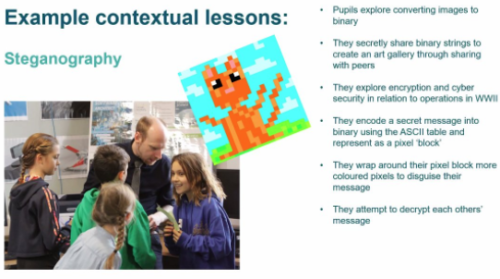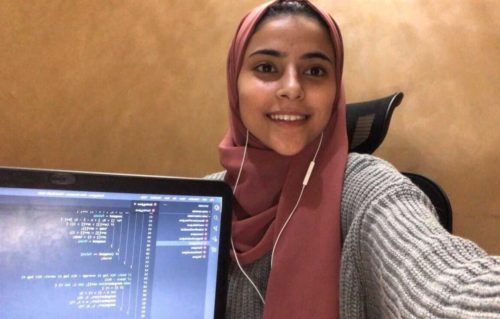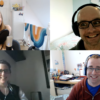What makes an impact on gender balance in computing education? Answers from experts
The latest event in the Raspberry Pi Foundation series of research seminars was our first panel discussion, with formal and non-formal learning opportunities in computing education and their impact on gender balance as its theme.





The panel was chaired by Dr Yota Dimitriadi, Associate Professor of Computing at the University of Reading, who was joined by four expert speakers: Dr Jill Denner, Senior Research Scientist at ETR; Amali de Alwis MBE, Managing Director at Microsoft Startups and Founder of Code First: Girls; Pete Marshman FCCT, NCCE Computing Hub Leader at Park House School; and Carrie Anne Philbin MBE, Director of Educator Support here at the Raspberry Pi Foundation. The event opened with lightning talks from all speakers, followed by an interactive question-and-answer section. Our audience learned from a blend of research insights and lived experiences about practical ways to promote gender balance in both formal and non-formal computing education.

Broadening the tech sector employee pool and empowering all students to see computing as a life-changing, fulfilling subject remains an enduring issue in many countries around the world. In England, the proportion of girls choosing formal qualifications in computer science is slowly increasing, and a number of initiatives support the uptake of computing as a career for girls and women. Nevertheless, much remains to be done in order to present computing as an appealing option for girls. In this blog post, I present three key themes which were covered during the panel session. You can find the recording of the event at the bottom of the post.
Theme 1: Putting computing in context
Students often describe computing as a very abstract, academic subject. Dr Jill Denner shared that research has shown a promising approach to altering this perception: connecting the content of computing lessons to people’s everyday lives. Learners’ need for contextual lessons was reiterated by Pete Marshman. In his teaching, Pete has observed that the very first lesson in Year 7 (11-year-olds) is crucial, because students form opinions about computing immediately. Pete devised a lesson that uses collaborative play and pixel art to introduce steganography, a cybersecurity technique for hiding data in plain sight within an ordinary file or message.

Computing education research has much more to uncover about how computing can be presented as a relevant subject in formal education. In this vein, Carrie Anne Philbin gave an overview of the Relevance strand of the ground-breaking Gender Balance in Computing research programme (co-led by the Foundation). The programme’s Relevance strand will explore the impact of linking computing to real-world problem-solving, working with Year 8 pupils in more than 180 secondary schools in England.
Theme 2: Giving everyone a sense of belonging
A second theme that emerged during the panel discussion was to who belongs in computing, more specifically which groups self-identify as belonging in computing. Computing suffers from the perception of brilliance bias amongst students: many of them feel that they need genius-like abilities in order to succeed with their computing studies, and to many of them it seems like such abilities are most commonly exhibited by men. Amali de Alwis turned this concept upside down when she described the “human-centred design” of Code First: Girls courses. Women attending these courses learn from a volunteer with a group of peers and become part of a community where members support each other towards brilliance. Jill echoed this when she spoke about the need to challenge stereotypes, embed diversity in educational materials, and continue to educate teachers to create computing classrooms where girls feel that they belong.

In the Belonging strand of the Gender Balance in Computing programme, the researchers will look closely at the attitudes of both boys and girls towards computing, and Carrie Annie explained that giving learners the chance to talk to female role models from the tech sector may cause a measurable shift in their attitudes to the subject. Pete highlighted practical steps that every school can take by using internal role models drawn from the student body to inspire other pupils and produce influential peer-to-peer interactions. As Jill remarked so succinctly, educators need “to tell all students they belong in computer science”.
Theme 3: Presenting learners with role models and advocates
Finally, we heard about the role that adult and course leader expectations play in shaping young people’s attitudes towards computing. Eccles’ expectancy-value theory suggests that when girls and women make choices about a subject (or career), they are influenced by the perceptions that others hold about that subject. If parents, teachers, and course leaders unconsciously discourage girls from considering computing, then girls will take notice of this. However, adults also have opportunities to underline that they see the value of computing, as for example a parent from Pete’s school did by accompanying a school trip to Google’s offices. In non-formal learning spaces, educators can share insights about their own approaches to problem-solving in computing, such as learning from others’ code on GitHub. Amali believes that sharing this type of common workplace practice shows that in the tech sector you are not expected to be able to solve every problem alone, which helps girls and women feel that they can succeed in a computing career.

Final takeaways
The drop-off in female participation in computing between formal education and the workplace has often been presented as a leaky pipeline. This deficit-based model suggests that solutions need to be aimed at fixing the leaks in the pipeline, such as providing interventions at specific stages when girls make decisions about formal qualifications or careers. An alternative viewpoint and important takeaway from the panel was this: as a community of educators and researchers, we need to focus our efforts on identifying the unconscious bias that exists in computing education, so that we can dismantle the barriers that this bias has created and ensure girls have access to equitable computing education at all stages of their learning.

During the question-and answer-session, Dr Yota Dimitriadi skillfully drew out and linked some key factors to encourage girls and women to flourish in computing. The audience heard about the need for advocates at all levels in schools to support careful and thoughtful timetabling of computing lessons. Questions about overcoming negative learning experiences and succeeding later in life elicited thoughts from the panel about how non-formal learning can break down learners’ preconceived ideas about computing and show that it’s never too late to learn.
Watch the recording of the event here:
More research is urgently needed
A recent report from Engineering UK suggests that one possible impact of the coronavirus pandemic is a widening of the existing gender gap in young people’s engineering or technology career aspirations. That means the need to promote gender-equitable learning spaces in both formal and non-formal computing education is even more pressing now.
Research to provide evidence-informed solutions will be absolutely crucial to shifting the gender balance in computing. The Raspberry Pi Foundation is a lead organisation in the Gender Balance in Computing research programme, funded by the Department for Education to identify scalable approaches to improving the gender balance in computing. We are currently recruiting primary and secondary schools in England to take part in trials starting in September 2021 and January 2022. Sign up or find information to share with your networks.
Next up in our free series
In our next research seminar on Tuesday 1 June at 17:00–18:30 BST / 12:00–13:30 EDT / 9:00–10:30 PDT / 18:00–19:30 CEST, we’ll welcome Dr Hayley Leonard and Thom Kunkeler from the Raspberry Pi Foundation team. They will be talking about ‘Why the digital divide does not stop at access: understanding the complex interactions between socioeconomic disadvantage and computing education’. To join this free event, click below and sign up with your name and email address:
We’ll send you the link and instructions. See you there!
You can now download the first volume of our seminar proceedings, with contributions from our previous guest speakers.







2 comments
Stuart Andrew Jones
I have spent a large chunk of my computing lifetime (nearly 60 years total) encouraging girls (including my two daughters) to become computer wizardettes. I provided my real and part-time daughters (their many friends) with free access to my basement laboratory (20 PCs) and library. Yet, the total yield of these efforts was a total of 1 lady who now works as an elementary school teacher and local IT resource. Where did I go wrong? I believe it is not enough to provide access to computing resources and intermittent encouragement to overcome the bias currently built into our so-called education system (really a non-system plagued by retrogressive, prejudiced, superstitious, and abysmally STUPID culture warriors on school boards and state education commissions, creating curricula and study plans that actively discourage girls from excelling in STEM pursuits). If we want more wizardettes (and we desperately NEED them) we must continue to develop activist programs like those described in the above post. However, I also believe that these activities should also include some boys, with the aim of educating them to appreciate, encourage, and benefit from exposure to female computing talent. If we wish to overcome bias, we must educate BOTH (or should I say ALL) sexes to promote gender equality and gender-blind excellence in computing.
Andrew
I fail to understand why there is this persistent effort to create an outcome based on gender in IT when the gender numbers in other careers pass without comment . IT is open to everyone but maybe it just isn’t as appealing to some people (perhaps people that have traditionally been attracted to roles with high levels of people interaction for example). Please ditch the equality of outcome and focus on providing equality of opportunity.